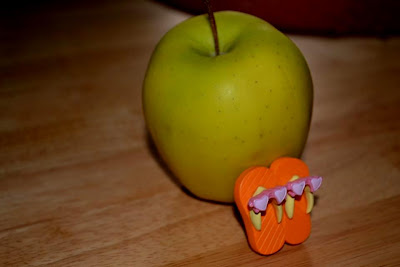A simple fruit is a type of fruit that is created from only one pistol thats from a simple or compound ovary in a flower. Some examples are bananas and apples.
Sources: Simple fruit. (May 11, 2008) biology-online.org. Retrieved on September 5, 2011, from
http://www.biology-online.org/dictionary/Simple_fruit
AP Biology Summer Assignment
This blog will contain 20 biology vocabulary words. Each blog will contain the word, description, a photo showing an example of that word, and the source the information came from. Also, each picture will have a "widget" or "mascot" that provides proof that I took the picture. My mascot is a flip flop magnet. Hope you enjoy!
Tuesday, September 6, 2011
Aggregate fruit
An aggregate fruit is a type of fruit that is made from one single flower that has numerous pistols. Raspberries, blueberries, and strawberries are some prime examples. This is why I drew a strawberry.
Sources: Aggregate fruit. (June 5, 2009) biology-online.org. Retrieved on September 5, 2011, fromhttp://www.biology-online.org/dictionary/Aggregate _fruit
Base
In chemistry, the pH is the measure of basicality or acidity a substance has. Some people use the pH scale to determine how acidic or basic the substance is. It ranges from 0-14. A pH greater than 7 is considered a base. An example of a base is egg whites, which is why there is a picture of an egg white below. Some common qualities of a base would be that they sometimes will have a slippery feel to them, and they are bitter.
Source:
N/AOrganism
To be considered an organism it must apply to the following...it must
- React to change
- Be able to reproduce
- Maintain homeostasis
- Grow
Source: Organism. (June 17, 2008). biology-online.org. Retrieved on September 5, 2011, from
http://www.biology-online.org/dictionary/Organism
http://www.biology-online.org/dictionary/Organism
Herbivores
A herbivore is an animal that feeds off of mainly grasses and other plants. Many hooved animals are herbivores such as moose and deer. Some other herbivores are pandas, rabbits, and rhinos. Many dinosaurs are believed to also of been herbivores, such as the parasaurolophus. This specific dinosaur was drawn below as an example of a herbivore.
Source: Herbivore. (May 11, 2007). biology-online.org. Retrieved on September 5, 2011, from
http://www.biology-online.org/dictionary/Herbivore
http://www.biology-online.org/dictionary/Herbivore
Invertebrate
Invertebrates lack a vertebrae, so it does not have a back bone. An example of an invertebrate is a starfish which is why i took a picture of one to represent this specific vocabulary word.
Source: Invertebrate. (October 3, 2005). biology-online.org. Retrieved on September 5, 2011, from
http://www.biology-online.org/dictionary/Invertebrate
http://www.biology-online.org/dictionary/Invertebrate
Heterotroph
A heterotroph is an organism that is not self sufficient. In other words, it is not like a plant, where it can create its own food and survive on its own. They are unable to synthesize, therefore they depend on other organic matter created by other organisms. Examples of a heterotroph could be a dog, an elephant, humans, lions, and many others. The drawing below is another example of a heterotroph, which is a south african oryx. This animal is a herbivore, which means it needs organisms such as grass and other vegitation to survive.
Source: Heterotroph. (July 6, 2008). biology-online.org. Retrieved on September 5, 2011, from
http://www.biology-online.org/dictionary/Heterotroph
http://www.biology-online.org/dictionary/Heterotroph
Subscribe to:
Comments (Atom)







